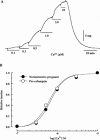Characterization of changes in mechanical responses to histamine in omental resistance arteries in pre-eclampsia
- PMID: 10960066
- PMCID: PMC1572289
- DOI: 10.1038/sj.bjp.0703529
Characterization of changes in mechanical responses to histamine in omental resistance arteries in pre-eclampsia
Abstract
Changes in the effect of histamine on the smooth muscle of resistance arteries in pre-eclampsia were investigated by measuring isometric contractions in endothelium-denuded strips of omental resistance arteries from pre-eclamptic and normotensive pregnant women (pregnancy-term matched). Histamine (0.03 -1 microM) caused concentration-dependent relaxation of the contraction induced by 9, 11-epithio-11,12-methano-thromboxane A(2) (STA(2)) in strips from both groups. Sensitivity (for pre-eclampsia: pD(2)=6.66+/-0.04, n=5 and for normotensive pregnant women: pD(2)=7.07+/-0.03, n=10, P<0.001) was lower and the maximum response (90.6+/-0.6% vs 95.5+/-1.1%, P<0.05) was smaller in strips from pre-eclamptic women. Although 8-bromoadenosine-3', 5'-cyclic monophosphorothioate (Sp-isomer: Sp-8-Br-cAMPS, 0.1 - 0.3 mM), a phosphodiesterase (PDE)-resistant activator of adenosine-3',5'-cyclic monophosphate (cyclic AMP)-dependent protein kinase, concentration-dependently attenuated the contraction induced by STA(2) in strips from both groups, the sensitivity (for pre-eclampsia: pD(2)=3.68+/-0.04, n=5 and for normotensive pregnant women: 3.94+/-0.09, n=7, P:=0.02) was lower and the maximum response (64.2+/-2.4% vs 74.9+/-4.4%, P:<0.05) was smaller in pre-eclampsia. In beta-escin-skinned strips, the pD(2) value for the contraction-inducing effect of Ca(2+) did not differ significantly between the two groups (for pre-eclampsia, n=6; for normotensive pregnant women, n=6). Thus, omental resistance arteries from human subjects with pre-eclampsia showed (i) a weaker H(2)-receptor-mediated relaxation to histamine and (ii) a weaker cyclic AMP-analogue-induced relaxation, suggesting that the reduced action of histamine may be partly due to a decreased effect of cyclic AMP.
Figures





Similar articles
-
Mechanisms underlying the reduced endothelium-dependent relaxation in human omental resistance artery in pre-eclampsia.J Physiol. 2000 Aug 15;527 Pt 1(Pt 1):163-74. doi: 10.1111/j.1469-7793.2000.00163.x. J Physiol. 2000. PMID: 10944179 Free PMC article.
-
Effects of formoterol and BRL 37344 on human umbilical arteries in vitro in normotensive and pre-eclamptic pregnancy.Vascul Pharmacol. 2007 May;46(5):360-6. doi: 10.1016/j.vph.2006.12.002. Epub 2006 Dec 8. Vascul Pharmacol. 2007. PMID: 17229593
-
Reduced function of endothelial prostacyclin in human omental resistance arteries in pre-eclampsia.J Physiol. 2002 Nov 15;545(1):269-77. doi: 10.1113/jphysiol.2002.022384. J Physiol. 2002. PMID: 12433966 Free PMC article.
-
Modified histamine-induced NO-mediated relaxation in resistance arteries in pre-eclampsia.Eur J Pharmacol. 2000 Dec 20;410(1):7-13. doi: 10.1016/s0014-2999(00)00825-6. Eur J Pharmacol. 2000. PMID: 11134651
-
Neurovascular mechanisms of hypertension in pregnancy.Curr Neurovasc Res. 2006 May;3(2):131-48. doi: 10.2174/156720206776875885. Curr Neurovasc Res. 2006. PMID: 16719796 Review.
Cited by
-
Modulation of cell adhesion and viability of cultured murine bone marrow cells by arsenobetaine, a major organic arsenic compound in marine animals.Br J Pharmacol. 2001 Jan;132(1):143-50. doi: 10.1038/sj.bjp.0703790. Br J Pharmacol. 2001. PMID: 11156571 Free PMC article.
References
-
- CHEN X.L., REMBOLDC M. Nitroglycerin relaxes rat tail artery primarily by decreasing [Ca2+]i sensitivity and partially by repolarization and inhibiting Ca2+ release. Am. J. Physiol. 1996;271:H962–H968. - PubMed
-
- CINES D.B., POLLAK E.S., BUCK C.A., LOSCALZO J., ZIMMERMAN G.A., MCEVER R.P., POBER J.S., WICK T.M., KONKLE B.A., SCHWARTZ B.S., BARNATHAN E.S., MCCRAE K.R., HUG B.A., SCHMIDT A.M., STERN D.M. Endothelial cells in physiology and in the pathophysiology of vascular disorders. Blood. 1998;91:3527–3561. - PubMed
-
- CUNNINGHAM F.G. Hypertensive disorders in pregnancy. Williams Obstetrics 1998Connecticut: Appleton & Lange; 693–744.20th edn., ed. Cunningham, F.G., MacDonald, P.C., Leveno, K.J., Gant, N.F. & Gilstrap, L.C. III pp
-
- EL-ACKAD T.M., BRODY M.J. Evidence for non-mast cell histamine in the vascular wall. Blood Vessels. 1975;12:181–191. - PubMed
-
- HILL S.J., GANELLIN C.R., TIMMERMAN H., SCHWARTZ J.C., SHANKLEY N.P., YOUNG J.M., SCHUNACK W., LEVI R., HAAS H.L. International Union of Pharmacology. XIII. Classification of histamine receptors. Pharmacol. Rev. 1997;49:253–278. - PubMed
Publication types
MeSH terms
Substances
LinkOut - more resources
Full Text Sources
Miscellaneous

